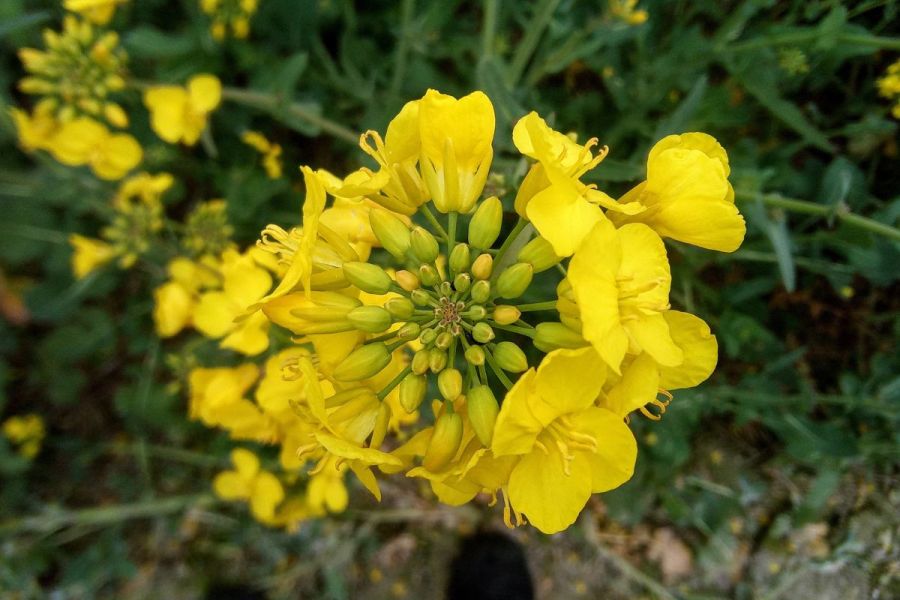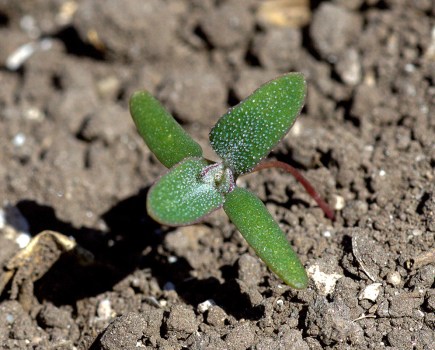A recent study has discovered a species of the phoma pathogen has become less sensitive to azole chemistry. CPM explores the findings of the research and what implication this could have on disease control.
“Azoles are the cornerstone of our disease control strategy.”
By Melanie Jenkins
Depending on the year and who’s being asked, phoma will either be the top or the second most prominent oilseed rape disease in the UK. Luckily, growers have had access to robust fungicides to control the disease, but now azole resistance has been detected, could this be about to change?
According to Dr Kevin King, plant pathologist at Rothamsted Research, OSR is facing a stream of emerging threats, but by having a better understanding of the pathogen population biology, this can help the industry to better protect the crop. One of the threats Kevin has identified in a recent study means azole chemistry is no longer as effective against phoma as it’s previously been.
The study (co-funded by UKRI and BASF) was led by Kevin, and published in the journal Plant Pathology in March, has revealed that one of the two fungal species responsible for phoma leaf spot and stem canker is now showing decreased sensitivity to azole chemistry. “Phoma is caused by Plenodomus lingam (Leptosphaeria maculans) and P. biglobosus (L. biglobosa). P. lingam isolates were first identified as showing decreased sensitivity to azoles in Australia and eastern European countries but we’ve now detected sensitivity shifts in isolates from western European countries, including the UK.”
Despite resistance being identified, this doesn’t mean azole chemistry will no longer work, stresses Kevin. “It might work less well than it has done previously, but this won’t result in azoles not working in the field at all. However it’s a warning for the direction of travel.”
According to data from AHDB, phoma is responsible for losses of £100M each season, highlighting just how important access to effective chemistry is. Azoles were identified as the most commonly applied fungicide on OSR crops in 2022, with around 536,000ha treated with them, while strobilurins and SDHIs were used less frequently, according to the study.
Up until 2022/23 when the research was carried out, neither of the phoma pathogens in Wester Europe had shown any meaningful resistance to azole fungicides, explains Kevin. “It was quite unusual in this respect. We’d seen resistance in light leaf spot but none in phoma until the first reports of it in Australia in 2017.
“But now, decreased sensitivity of azole fungicides for P. lingam is widespread in Western Europe. Our results show that it certainly wasn’t present in the UK a few years ago but there’s resistance in England, Ireland and maybe Wales, and it’s at a worryingly high level of about 85% of the isolates we tested, suggesting rapid and recent changes in pathogen populations,” he says.
“Azoles are the cornerstone of our disease control strategy – if growers are going to spray anything, it’ll be an azole,” notes Kevin. “These act as inhibitors for a fungal enzyme, targeting the CYP51 gene, which is responsible for producing a sterol essential for cell survival.”
Resistance to fungicides typically occurs can occur in two main ways, he says. “The first is gene target site alterations, which the study found no evidence of. The second, and the one present in the P. lingam species, has seen a stretch of DNA inserted into the upstream promotor region that’s associated with decreased sensitivity to azole fungicides in almost all of the isolates that we looked at.
“This has resulted in a three to 10-fold decrease in sensitivity,” he highlights. “It’s important to note that this resistance has only been characterised in a laboratory and so it’s difficult to quantify the differences in terms of decreased sensitivity in the field. But any evidence of this should be of concern because if gene overexpression is already happening, in future we might also see target site resistance emerge in the pathogen population. If this happens, both mechanisms will likely work in combination to decrease sensitivity to azole fungicides significantly. At that point, we might be looking at some degree of failure where azoles are applied against phoma.”
The good news is that there’s no signs of target site resistance and so far only P. lingam is demonstrating decreased sensitivity to azole chemistry, meaning P. biglobosus can still be controlled by it, says Kevin. “Furthermore, no resistance has been detected to SDHIs or strobilurins, so there’s still good chemistry available for use against the pathogens.”
Up until the results of this most recent study, research had identified P .lingam as being slightly more sensitive to fungicides than P. biglobosus, he adds. “Growers have previously tried to exclusively target P. lingam since it was the one most often associated with larger leaf lesions and cankers on stems. But what we have now is a situation where we should be targeting both species for sustainable control of phoma.”
Another issue is that P. biglobosus has increased in importance during the past few years most likely because cultivar resistance being deployed was only effective against the P. lingam strain, explains Kevin. “There’s no known genetic host plant resistance to P. biglobosus so this was putting selective pressure towards this species in the pathogen population. But because P .lingam is now less sensitive of the pathogen species to azole fungicides the situation could switch around again and it could become an increasingly important problem.”
So what does this mean in practical terms and what can growers do? “OSR is becoming a bit of a marmite crop, growers either love it or hate it,” says Agrovista’s James Cheney. “But it’s a key part of our arable rotations in the UK as we don’t have many break crop options.
“However, with the combined loss of neonicotinoids and the increasing cabbage stem flea beetle burden, if you add in fungicide resistance to the mix, this could make it even more difficult to grow, squeezing margins and adding pressure to an already difficult situation.
“Now we’re dealing with fungicide resistance in the crop, this moves OSR into the territory of things such as potatoes and cereals which we’ve seen resistance in for some time. Azoles are older chemistry, meaning they’re often cheaper and are preferable when margins are squeezed – they’re the chemistry everyone reaches for,” highlights James.
“But given that there’s now resistance to this chemistry, we’re going to have to be proactive in our approach to fungicide sprays so that we don’t end up on the backfoot chasing phoma. This means being aware of the risks, not relying too heavily on one type of chemistry and ensuring we’re mixing modes of action.”
James recommends taking an approach that starts with the soil. “Integrated pest management is a tool we can use to manage fungicide resistance, as well as prolonging the effective life of chemistry. Start by becoming soil health-orientated and getting it into the best condition possible.
“From this point it’s key to optimise OSR establishment with good levels of nutrition to get the plants growing well. This’ll also help plants to cope with adult CSFB damage as well as disease pressures – a healthy crop will always be able to sustain ingression from disease better than a weaker plant.”
One way to improve plant health is by undertaking regular tissue testing throughout the season, says James. “This will indicate if plants are lacking in nutrition and will allow you to tailor your approach to nutrient applications more precisely, driving plant health. However, tissue sampling will obviously incur an extra cost, but if you adjust your nutrient applications as a result, it might mean you’re only spending on the nutrients your plants require, rather than resorting to blanket applications.”
Selecting varieties with genetic tolerances and resistances is another way to manage disease, but James points out that this is just one part of the bigger picture. “Selecting a variety with strong phoma resistance doesn’t mean cutting back on fungicide spend. Instead, resistance should only be relied upon as a management tool for when spray windows aren’t available. Crops have to be looked after irrespective of resistance which just allows you more time to apply fungicides to a crop.”
But Kevin flags that although growing resistant cultivars should be part of a wider disease management strategy, genetic resistance will still break down over time. “We’re already seeing instances where Rlm7 is breaking down due to the changing pathogen population to the disease. There are other countries that have a gene monitoring system to make sure cultivars are only grown in regions where the resistance will be effective, but this isn’t something we do here.”
James also warns growers to not cut fungicides rates. “It’s a false economy to trim rates to save a few pounds per hectare. By doing this you’ll unintentionally open the door for disease to potentially enter crops. It might seem expensive at the time, but opting for the most robust fungicide programme usually pays you back at the end of the day.
“It’s fortunate that resistance has only appeared in one phoma species so far. This means it’s really important that we stay proactive and keep rates high to help slow the spread. So keep dose rates up and mix modes of action by including SDHIs and strobilurins in programmes to ensure you’re not just using azoles.”
Kevin concurs, stressing the importance of appropriate resistance management through the use of mixtures. “Do your research into resistance management and ensure that azoles are being applied with other modes of action and that you’re mixing and rotating the products you use. This is all part of the bigger picture of disease management and it links up with applying products at the appropriate time and the recommended rates. Rothamsted Research hosts a phoma forecast on its website which is a further tool you can use to plan your management.”
As well as highlighting the importance of robust fungicide programmes, the detection of resistance to azoles also flags how vital it is to proactively monitor pathogens and the effectiveness of actives against them, says Kevin. “The next step on from the study is to take this research out into the field as there are lots of implications to our findings that can only be explored through further investigation, but this is always hindered by funding.”
Kevin stresses that field studies will allow him to identify the distribution of the resistance. “We’re working on a comprehensive study in collaboration with ADAS, but without further funding, this is limited. And it’s also important for us to be able to identify emerging risks, so far we only really have the first link in the chain.
“Every year we apply a huge amount of fungicide and this imposes a huge selective pressure on the pathogen populations and we’ve already seen just how quickly these can change,” says Kevin. “Although it’s important to note that azoles are still working against phoma, so far we’ve only seen the emergence of resistance, this does mean we have to be proactively monitoring for further developments that could well be more damaging.”
This article was taken from the latest issue of CPM. Read the article in full here.
For more articles like this, subscribe here.
Sign up for Crop Production Magazine’s FREE e-newsletter here.




